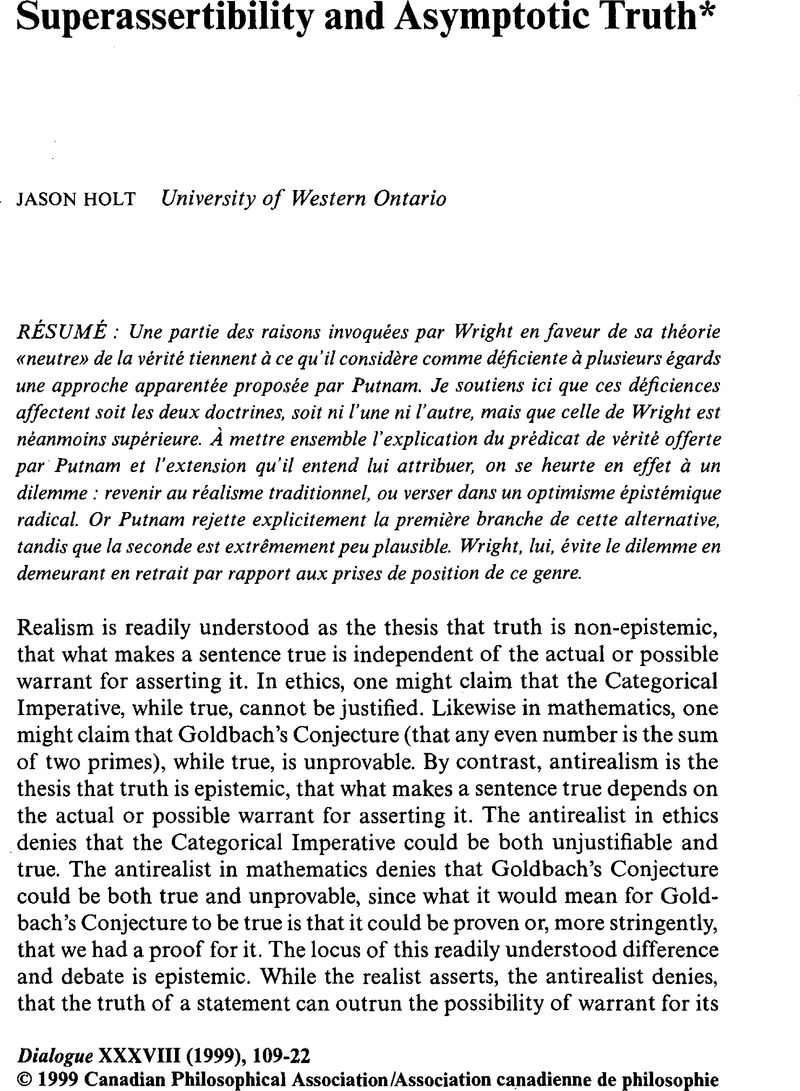No CrossRef data available.
Article contents
Superassertibility and Asymptotic Truth*
Published online by Cambridge University Press: 13 April 2010
Abstract

- Type
- Articles
- Information
- Dialogue: Canadian Philosophical Review / Revue canadienne de philosophie , Volume 38 , Issue 1 , Winter 1999 , pp. 109 - 122
- Copyright
- Copyright © Canadian Philosophical Association 1999
References
Notes
1 Wright, Crispin, Truth and Objectivity (Cambridge, MA: Harvard University Press, 1992), pp. 60–61. For Putnam, see note 4.Google Scholar
2 For a review of Putnam's various arguments to this effect, see Sosa, Ernest, “Putnam's Pragmatic Realism,” Journal of Philosophy, 90 (1993): 605–26.CrossRefGoogle Scholar
3 Wright, Truth and Objectivity, pp. 11–12, 25.
4 Putnam, Hilary, Reason, Truth and History (Cambridge, UK: Cambridge University Press, 1981), p. 55.CrossRefGoogle Scholar
5 Ibid.
6 Putnam, Hilary, Realism with a Human Face (Cambridge, MA: Harvard University Press, 1990), p. viii.Google Scholar
7 Putnam, Reason, Truth and History, p. 56.
8 Wright, Truth and Objectivity, p. 48.
9 This notion of warrant is suggested, if not explicitly endorsed, in Wright, Crispin, “Can a Davidsonian Meaning-Theory Be Construed in Terms of Assertibility?” in his Realism, Meaning and Truth (Oxford: Blackwell, 1987), pp. 287–317.Google Scholar
10 Ibid., p. 298. My breakdown of SA departs somewhat from Wright's presentation. The difference in presentation is idiosyncratic, however. Wright clearly assumes that the belief-set {B1,…, Bn} is achievable. I make this explicit as a point of comparison with Putnam's view, since it is prima facie unclear whether, and, if so, how, ideal epistemic states are achievable. In the discussion that follows this will become evident.
11 Wright, Truth and Objectivity, p. 40.
12 Ibid., pp. 40–41.
13 Ibid., p. 39.
14 Ibid., pp. 45–46.
15 Ibid., p. 56.
16 Putnam does not like this characterization (see his Realism with a Human Face, p. viii). What bothers Putnam about it is that it seems equivalent to the “utopian” notion of the limit of inquiry, where this limit is understood to be beyond the human pale. Where the limit of inquiry is understood as I suggest, without such overtones, I do not think Putnam would or should have a problem with it.
17 Ibid., p. ix.
18 Ibid.
19 Wright, Truth and Objectivity, pp. 67–68.
20 Davies, David, “A Traveller's Guide to Putnam's ‘Narrow Path’,” Dialogue, 35 (1996): 138.CrossRefGoogle Scholar


